by C. Elkins, OK Math and Reading Lady
Starting in 3rd grade, students start using words and symbols to read and write fractions (Oklahoma Academic Standards OAS 3.N.3.1), construct fractions (3.N.3.2), compose and decompose them (3.N.3.3), and order and compare them using models and number lines (3.N.3.4). Fourth and Fifth graders continue to refine these skills. In this post, I will address different ways to compare fractions (keeping in mind the concrete-pictorial-abstract progression) by comparing numerators, comparing denominators, comparing to half, and utilizing knowledge of unit fractions. Students should have extensive experience utilizing models such as fraction strips, fraction circles, pattern blocks, number lines, pictures, and drawings to help build the concepts of fractional parts before being asked to put a <, >, or = sign between two fractions. See the end for a FREE comparing fractions guide.
 In my opinion, determining if (or how) two fractions are equivalent is also a very important step when comparing fractions. However, regarding the OAS, students are not asked to represent or rename equivalent fractions until 4th grade (4.N.2.1). I will address equivalent fractions in the next post – just know that sometimes this skill goes hand in hand with comparing fractions. AND keep in mind that most of the standards for fractions through 4th grade stipulate “using concrete and pictorial models, fraction strips, number lines.” Students in 4th grade should not be expected to do abstract paper-pencil steps to simplify or “reduce” fractions to simplest terms, nor cross multiply to compare, etc. They need hands-on experience to more fully understand the concepts about fractions that are so difficult to grasp abstractly. Then in 5th grade students should have enough visual pictures in their head to solve operational problems with fractions. OK, that’s my soapbox. Don’t make it harder than it should be.
In my opinion, determining if (or how) two fractions are equivalent is also a very important step when comparing fractions. However, regarding the OAS, students are not asked to represent or rename equivalent fractions until 4th grade (4.N.2.1). I will address equivalent fractions in the next post – just know that sometimes this skill goes hand in hand with comparing fractions. AND keep in mind that most of the standards for fractions through 4th grade stipulate “using concrete and pictorial models, fraction strips, number lines.” Students in 4th grade should not be expected to do abstract paper-pencil steps to simplify or “reduce” fractions to simplest terms, nor cross multiply to compare, etc. They need hands-on experience to more fully understand the concepts about fractions that are so difficult to grasp abstractly. Then in 5th grade students should have enough visual pictures in their head to solve operational problems with fractions. OK, that’s my soapbox. Don’t make it harder than it should be.
Materials to use: pattern blocks, fraction strips, fraction circles, cubes, tiles, two-color counters, Cuisenaire rods, number lines, paper plates, graham crackers, candy (m and m’s, skittles, etc.)
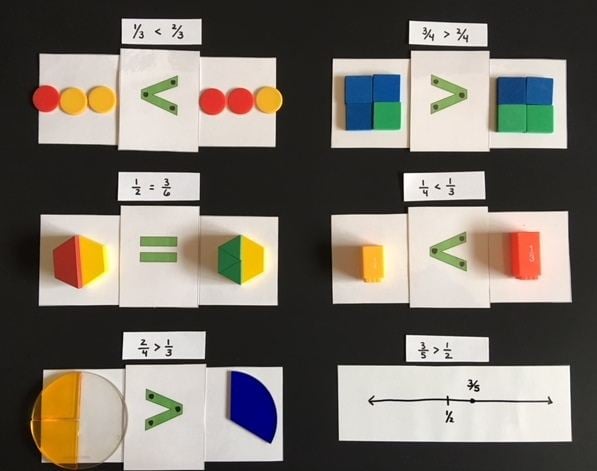
Ways to Compare (when using same size wholes – you can’t compare 3/4 of a donut with 1/2 of a birthday cake):
- Using unit fractions: If the fraction is a unit fraction, it has a 1 as a numerator. This should form the first type of comparison: 1/2 > 1/3 and 1/5 < 1/4 and 1/6 > 1/10, etc. This type of comparison is critical to fractional understanding.
- Same denominator: When the denominators are the same, then compare the numerators. 2/4 > 1/4.
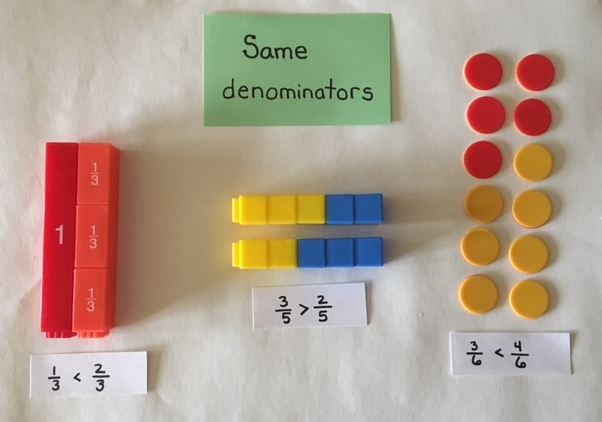
- Same numerator: When the numerators are the same, compare the denominators. For example: When comparing 2/5 with 2/10, since fifths are larger parts than tenths, 2/5 will be larger than 2/10. This is hard for some students to think about, because the smaller the number designated for the denominator, the larger the part (when comparing the same size whole).

- Unit fractions one away from the whole: These are fractions in which there is one unit to be added to make it a whole (1). The numerators of these fractions will be one less than the denominator. 11/12 is 1/12 away from the whole (1). 7/8 is 1/8 away from the whole (1). Example: To compare 3/4 with 5/6, use manipulatives or a number line to see that 3/4 is 1/4 away from 1, while 5/6 is 1/6 away from 1. Since 1/4 is a bigger part than 1/6, then 3/4 < 5/6.
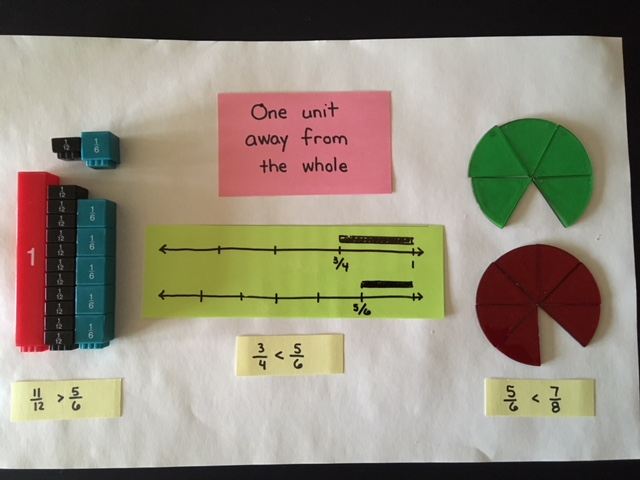
- Less than half? More than half? Learn all of the fractions that equal half. While this might sound simple, students often have misconceptions that 1/2 is the only way to describe half, or that a 5 must be in the fraction to be half (because 5 is the midpoint when used on a number line for rounding). I ask students to recall their addition facts dealing with doubles from 2nd grade. Since 2 + 2 = 4, two is half of 4, and 2/4 = 1/2. Repeat that with other forms of 1/2. Students should learn that finding half of an even-numbered denominator should be figured quickly (7/14, 9/18, 25/50, 50/100, etc.). Then use knowledge of half to determine if a fraction is less than half or more than half. Since 7/14 = 1/2, then I know that 6/14 < 1/2 and 9/14 > 1/2.
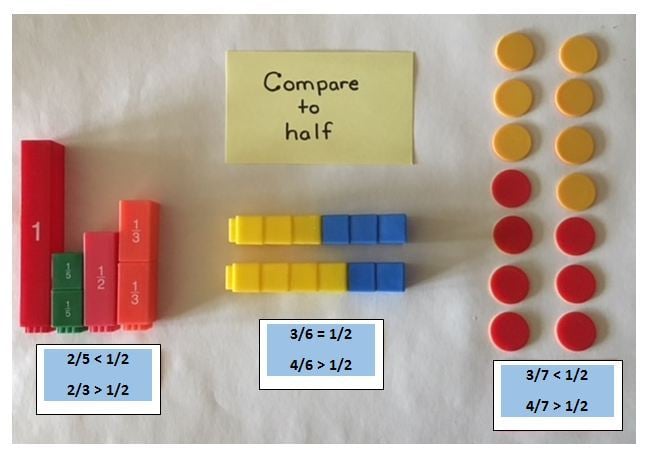
- Determining half with odd denominators: See picture above. To help students see half of an odd number, try this: Draw the number of circles to match the denominator. Count from the ends to find the middle and draw a vertical line. As shown with 7th, half would actually be 3 1/2 sevenths. Since 3 < 3 1/2, then we know 3/7 < 1/2. Do NOT use the circles method to compare fractions with different denominators – just to compare them to 1/2.
- Finding common denominators: To provide a visual understanding of finding common denominators to compare fractions, use an area model to partition and shade. Students should see the area shaded didn’t change, just that the size of the parts changed. Often students can’t conceptualize 2/3 = 4/6 because 4/6 has larger numbers, so they think 4/6 > 2/3. When this method is used, students are also naming equivalent fractions.
This pictures shows a similar method to see equivalent fractions with the set model.
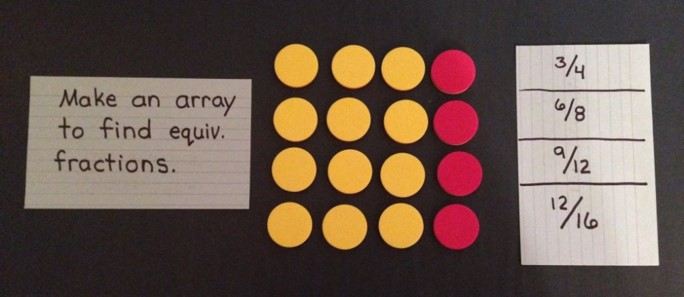
Finally, here is a copy of my comparing fractions reference guide. Click HERE for your FREE copy of the guide.
 And two youtube videos from Math Antics are good regarding some basics about fractions: Math Antics: Fractions are Parts and some good visuals for comparing fractions: Math Antics: Working with Parts
And two youtube videos from Math Antics are good regarding some basics about fractions: Math Antics: Fractions are Parts and some good visuals for comparing fractions: Math Antics: Working with Parts
Enjoy! Stay tuned for part 5 – Equivalent Fractions!
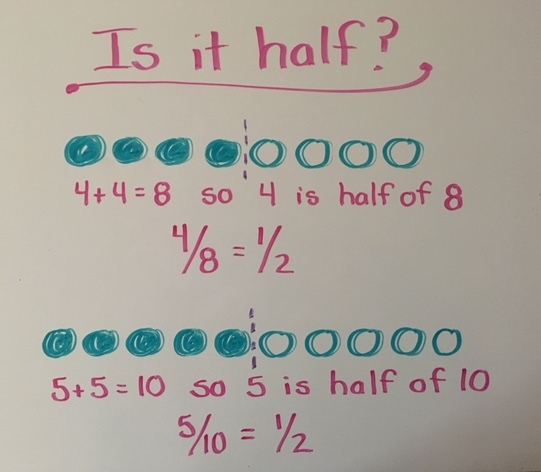

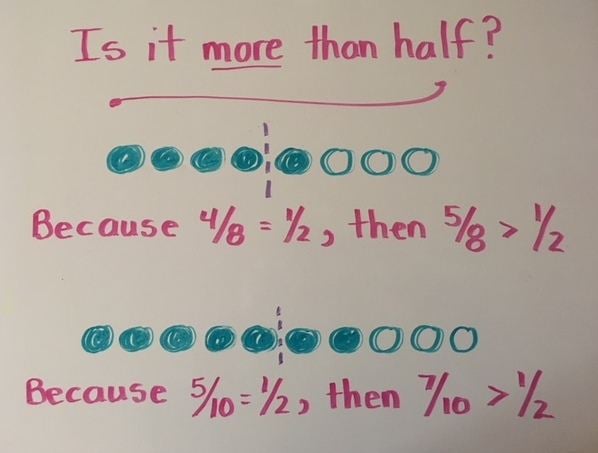
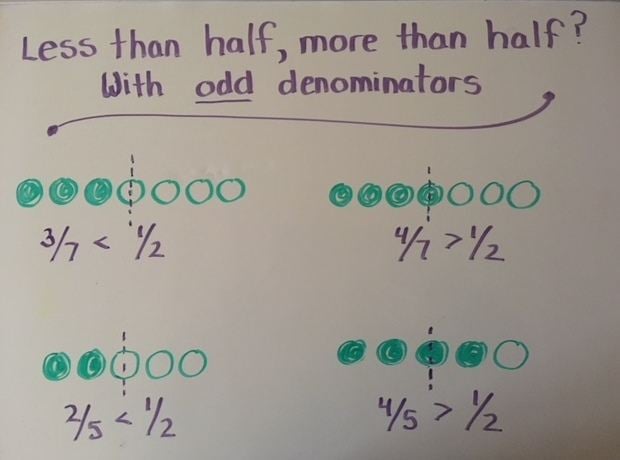

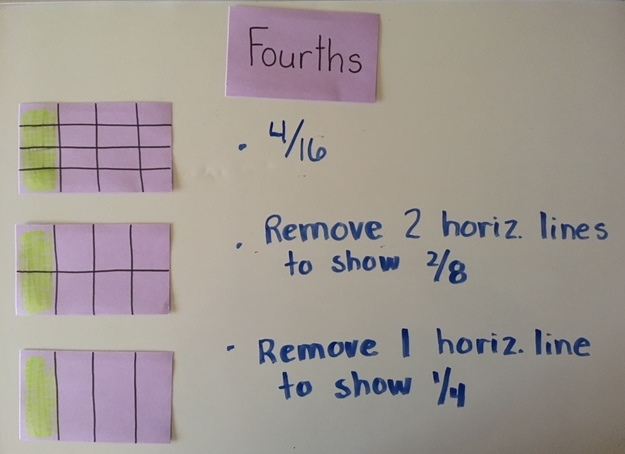
I love all the tips in this article! I can even see some things I could use in 2nd grade just in ways to show fractions using the manipulatives. Did I miss the meme era hip challenge? What is it?
Thank you! You should see my dining room when I’m “playing” with my manipulative to make the pictures!
I have a membership challenge until March 3rd. There are 3 ways you can enter for the $25 gift card challenge. 1) Subscribe to my blog. 2) Comment on a blog post (one entry per comment). 3)Invite a teacher friend who subscribes (let me know by emailing me their name and email address to Cindy.elkins2015@gmail.com).
Comparing fractions through activities and letting the idea of fraction diffuse into their mind is a very effective strategy to teach pupils about fractions. They will never forget that. Fraction is a lesson that we should never miss and a must to learn. It is a foundation that should be instilled on the minds of a young students. But sometimes doing it manually may result in a wrong answer. That is why I used a tool to confirm that the computation is correct. For checking if the calculation of fractions is correct, I used an app which shows the correct answer and display the step by step solution. It is actually a fraction calculator from http://www.fractioncalc.com. It is very useful in solving fraction and a very good tool to be used both by teacher and student for reference if their answer is correct and if their solution is right.
Thank you. I will check out the fraction calculator.